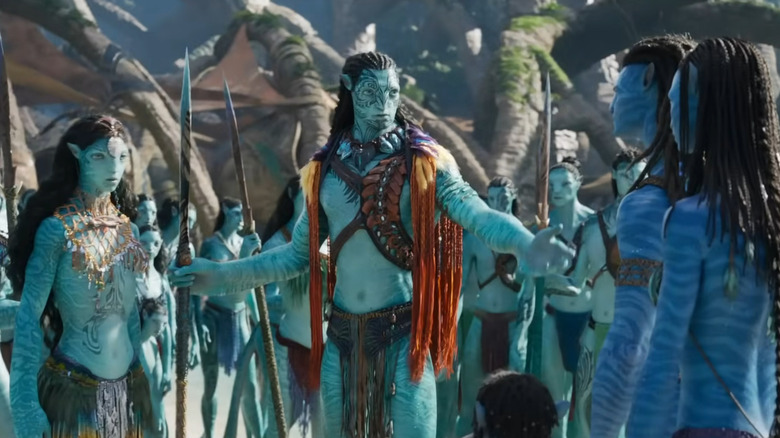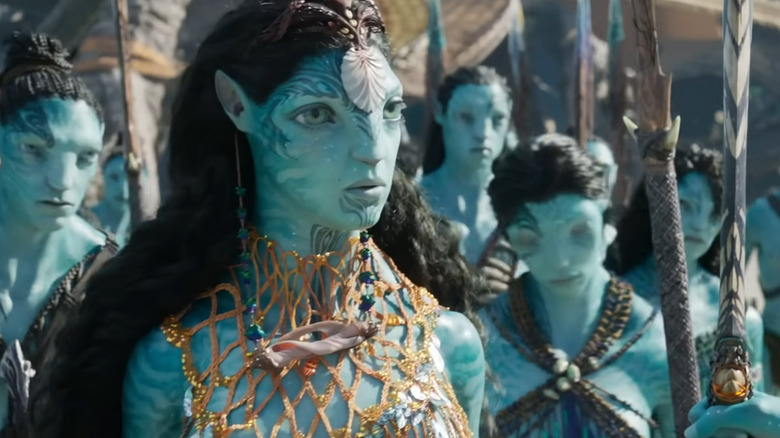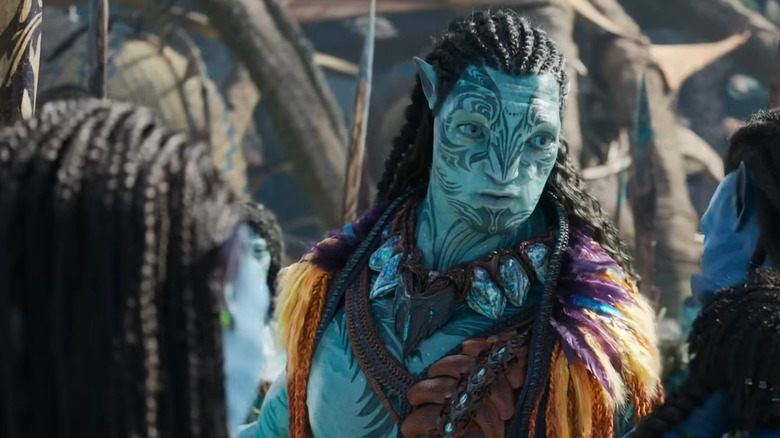The Look Of Avatar: The Way Of Water's Metkayina Came From Two Key Costume Designs
James Cameron's "Avatar" film series is an ongoing work of science fiction built upon more money and sheer human effort than any single Hollywood project has any right to be made with. And yet, somehow, it exists, so we're absolutely going to talk about it. Every frame of CGI (which is basically every frame of both films) denotes the combined skill of hundreds of VFX artists. Taking it a step further, every design that the VFX team brought to life denotes another tier of creators, whether it be Dylan Cole, who shaped the oceanic side of Pandora for "The Way of Water," or Deborah L. Scott, who clothed Cameron's Na'vi in both of the "Avatar" films.
You'd think that designing a few loincloths for fancy cartoon space aliens would be easy, especially for someone like Scott whose previous credits include everything from "Back to the Future" and "Titanic" to "The Amazing Spider-Man 2," but that's where you'd be wrong. Please don't misunderstand, it's not because Scott was improperly equipped for the task but rather because the task itself is, well, it's for Cameron. Nothing he does is ever simple.
In "The Art of Avatar the Way of Water," written by Tara Bennett to be a companion book for Cameron's sequel, Bennett details the extensive and surprisingly physical process that Scott experienced on her way to creating the aesthetic of the Metkayina. According to Bennett, it all started to come together once Scott locked in two key designs during the early phases of development.
Finding the right inspiration
According to Tara Bennett, Deborah L. Scott's primary challenge in designing costumes for "Avatar: The Way of Water" was to properly distinguish the Metkayina, the aquatic tribe of Na'vi, from the Omatikaya, the forest tribe of Na'vi. The intention behind Scott's work was to create pieces for these characters which served as a "visual extension of their personalities and cultures."
What's more, Scott believed that pieces should be informed by the character's surroundings, saying, "One of the core things that I think about when I'm creating a new costume is the circumstances under which it will be worn and how that will affect the motion, the sound, and things like that." To that end, each piece was 3D printed to test viability in a real space. With all this in mind, the design scheme for the tribe as a whole became more clear to Scott once she finalized the costumes for Tonowari (Cliff Curtis) and Ronal (Kate Winslet), the Metkayina's chieftain and chieftainess, respectively.
For Ronal, Scott was inspired by beachcombing in New Zealand. "Beautiful things wash up on the shore all the time, like pieces of shell, wood, plant life, all different shapes, colors, combining to make unique forms," she told Bennett. Specifically, Scott's attention was drawn to shells with repeating patterns that appeared both fabricated and organic. These she took back to Weta, the VFX team, to digitally recreate in their entirety.
Those shells became the impetus for Ronal's pāua top, which is comprised of innumerable, interwoven, carved shells. Ronal's costume is also unique in that she is the only Na'vi to wear a skirt. Scott's reasoning was that such a singularity would cause Ronal to stand out, even in a crowd. Its vibrant lavender shades, too, were inspired by New Zealand.
Balancing teams and themes
Another core tenet of creation that Deborah L. Scott carried throughout her early designs was the power of totems. With Tonowari in mind, and according to author Tara Bennett, James Cameron specifically shared an "affinity for the totemic power of things like teeth or claws — typical symbols of status and assertiveness — to visually state their position to the observer" with Scott, who stated that such symbols were difficult to balance with the Metkayina's culture, which was notably more passive than the Omatikaya from the first film.
It took Scott months to finalize a design for Tonowari's mantle piece, because creating a bone necklace that is both aesthetically pleasing and visually non-aggressive is no mean feat. She ultimately described the finished product by saying, "It's so strong, and it's virtually a solid pāua shell that has all the colors of the sea. It has everything about their culture right there around his neck. And it's very present."
Again, most of these pieces were not only 3D printed for evaluation but were also tested in CGI via the Weta Workshop, which means that, somewhere, there are innumerable mockups floating around that never even made it to the final stages. Scott told Bennett that Tonowari's mantle piece represented not only a high fidelity of design work but of deep artistic camaraderie between the multiple departments, as well. "When you're making things up, you're not sure what you want in the end," said Scott. "That mantle piece not only showed how hard the design process was, it showed how important it was for the two teams to work together."
And to think, all this effort was just to complete two costumes. There are easily hundreds of Na'vi in "Avatar." Cameron really never does anything simply, does he?


